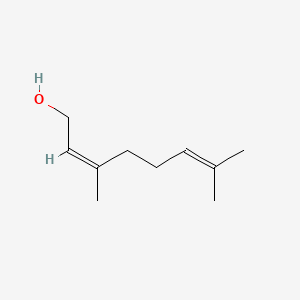| Authors | Title | Published | Journal | PubMed Link |
|---|---|---|---|---|
| Wang G et al. | [Analysis of chemical constituent of essential oil in Lonicera japonnica Thunb. cultivated on the northern plain of Henan Province]. | 1992 | Zhongguo Zhong Yao Za Zhi | pmid:1418559 |
| Vuts J et al. | Development of an attractant-baited trap for Oxythyrea funesta Poda (Coleoptera: Scarabaeidae, Cetoniinae). | 2008 Sep-Oct | Z. Naturforsch., C, J. Biosci. | pmid:19040118 |
| Hausen BM and Kulenkamp D | [Geraniol contact allergy]. | 1990 | Z. Hautkr. | pmid:2143044 |
| King A and Richard Dickinson J | Biotransformation of monoterpene alcohols by Saccharomyces cerevisiae, Torulaspora delbrueckii and Kluyveromyces lactis. | 2000 | Yeast | pmid:10790686 |
| Chadha A and Madyastha KM | Metabolism of geraniol and linalool in the rat and effects on liver and lung microsomal enzymes. | 1984 | Xenobiotica | pmid:6475100 |
| Stoianov S et al. | [Clinico-pharmacological studies of a modification of the preparation rosanol to decrease its cost]. | 1984 | Vutr Boles | pmid:6390970 |
| Katiki LM et al. | Anthelmintic activity of Cymbopogon martinii, Cymbopogon schoenanthus and Mentha piperita essential oils evaluated in four different in vitro tests. | 2011 | Vet. Parasitol. | pmid:21820807 |
| el Bahri L et al. | Artemisia campestris L: a poisonous plant of north Africa. | 1997 | Vet Hum Toxicol | pmid:9311092 |
| Ji P et al. | Monoterpene geraniol prevents acute allograft rejection. | 2002 | Transplant. Proc. | pmid:12176421 |
| Savage TJ et al. | Condensation of the isoprenoid and amino precursors in the biosynthesis of domoic acid. | 2012 | Toxicon | pmid:22041653 |
| Ahmad ST et al. | Preclinical renal cancer chemopreventive efficacy of geraniol by modulation of multiple molecular pathways. | 2011 | Toxicology | pmid:21907755 |
| Parodi A et al. | A comparative study of leukaemia inhibitory factor and interleukin-1alpha intracellular content in a human keratinocyte cell line after exposure to cosmetic fragrances and sodium dodecyl sulphate. | 2010 | Toxicol. Lett. | pmid:19878710 |
| Sieben S et al. | Characterization of T cell responses to fragrances. | 2001 | Toxicol. Appl. Pharmacol. | pmid:11312644 |
| Hagvall L et al. | Cytochrome P450-mediated activation of the fragrance compound geraniol forms potent contact allergens. | 2008 | Toxicol. Appl. Pharmacol. | pmid:18824010 |
| Tiwari M and Kakkar P | Plant derived antioxidants - Geraniol and camphene protect rat alveolar macrophages against t-BHP induced oxidative stress. | 2009 | Toxicol In Vitro | pmid:19135518 |
| Paterson A et al. | Environmental and seasonal influences on red raspberry flavour volatiles and identification of quantitative trait loci (QTL) and candidate genes. | 2013 | Theor. Appl. Genet. | pmid:22890807 |
| Duchêne E et al. | A grapevine (Vitis vinifera L.) deoxy-D: -xylulose synthase gene colocates with a major quantitative trait loci for terpenol content. | 2009 | Theor. Appl. Genet. | pmid:19002427 |
| Spiller M et al. | Genetic dissection of scent metabolic profiles in diploid rose populations. | 2010 | Theor. Appl. Genet. | pmid:20084491 |
| Zhou W et al. | [Studies of aroma components on essential oil of Chinese kushui rose]. | 2002 | Se Pu | pmid:12683009 |
| Xie W et al. | [Study on the pyrolysis behavior of geranyl-beta-D-glucopyranoside by gas chromatography-mass spectrometry]. | 2006 | Se Pu | pmid:17017155 |
Nerol
Nerol is a lipid of Prenol Lipids (PR) class. The involved functions are known as Odorant, Anabolism, Diastasis, Metabolic Inhibition and Oxidation. Nerol often locates in germ tube. The related lipids are Octanols, Pinene, Hexanols, ethyl butyrate and ethyl hexanoate.
Cross Reference
Introduction
To understand associated biological information of Nerol, we collected biological information of abnormalities, associated pathways, cellular/molecular locations, biological functions, related genes/proteins, lipids and common seen animal/experimental models with organized paragraphs from literatures.
What diseases are associated with Nerol?
There are no associated biomedical information in the current reference collection.
No disease MeSH terms mapped to the current reference collection.
PubChem Associated disorders and diseases
What pathways are associated with Nerol
There are no associated biomedical information in the current reference collection.
PubChem Biomolecular Interactions and Pathways
Link to PubChem Biomolecular Interactions and PathwaysWhat cellular locations are associated with Nerol?
Visualization in cellular structure
Associated locations are in red color. Not associated locations are in black.
Related references are published most in these journals:
| Location | Cross reference | Weighted score | Related literatures |
|---|
What functions are associated with Nerol?
Related references are published most in these journals:
| Function | Cross reference | Weighted score | Related literatures |
|---|
What lipids are associated with Nerol?
Related references are published most in these journals:
| Lipid concept | Cross reference | Weighted score | Related literatures |
|---|
What genes are associated with Nerol?
There are no associated biomedical information in the current reference collection.
What common seen animal models are associated with Nerol?
There are no associated biomedical information in the current reference collection.
